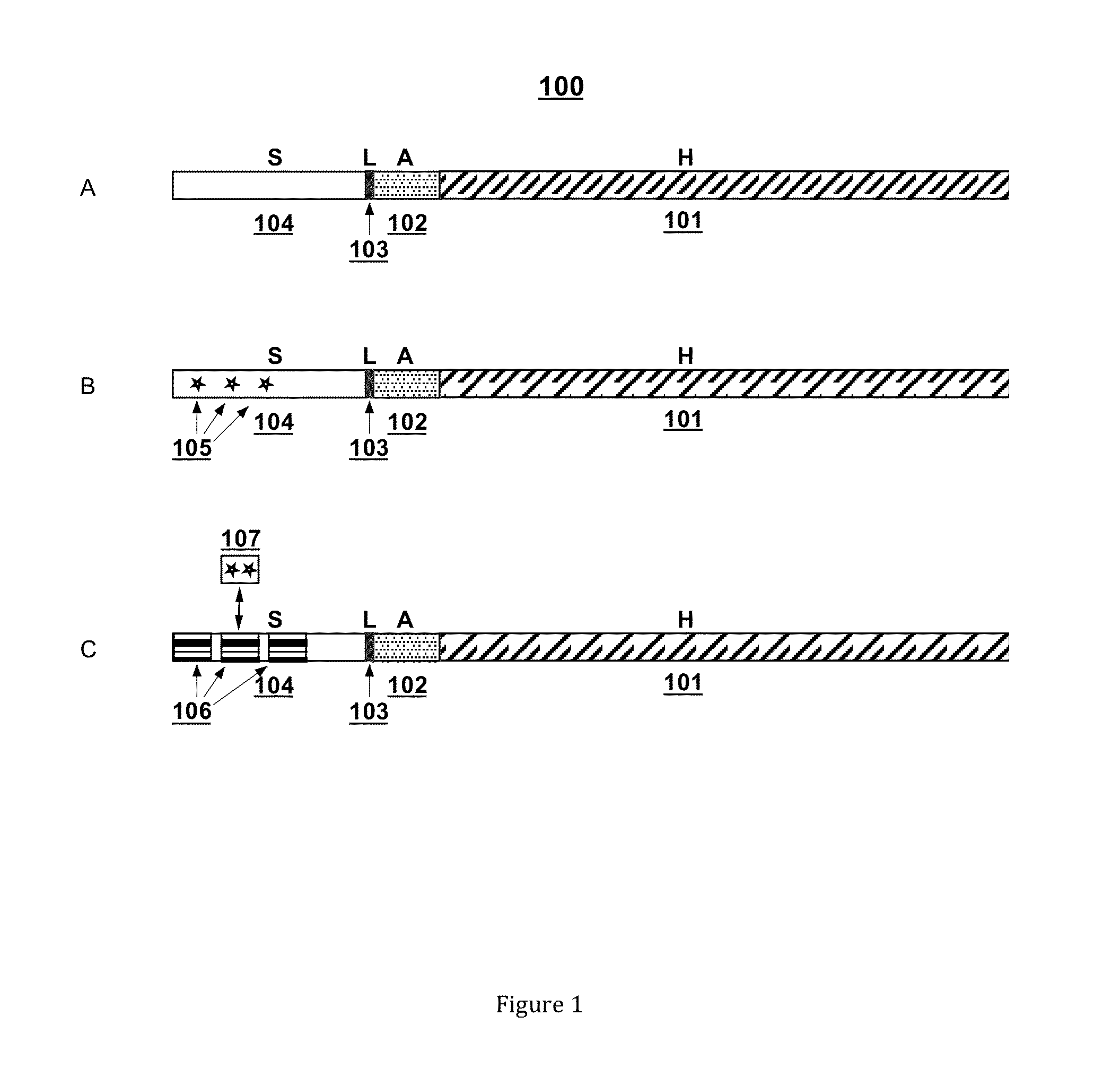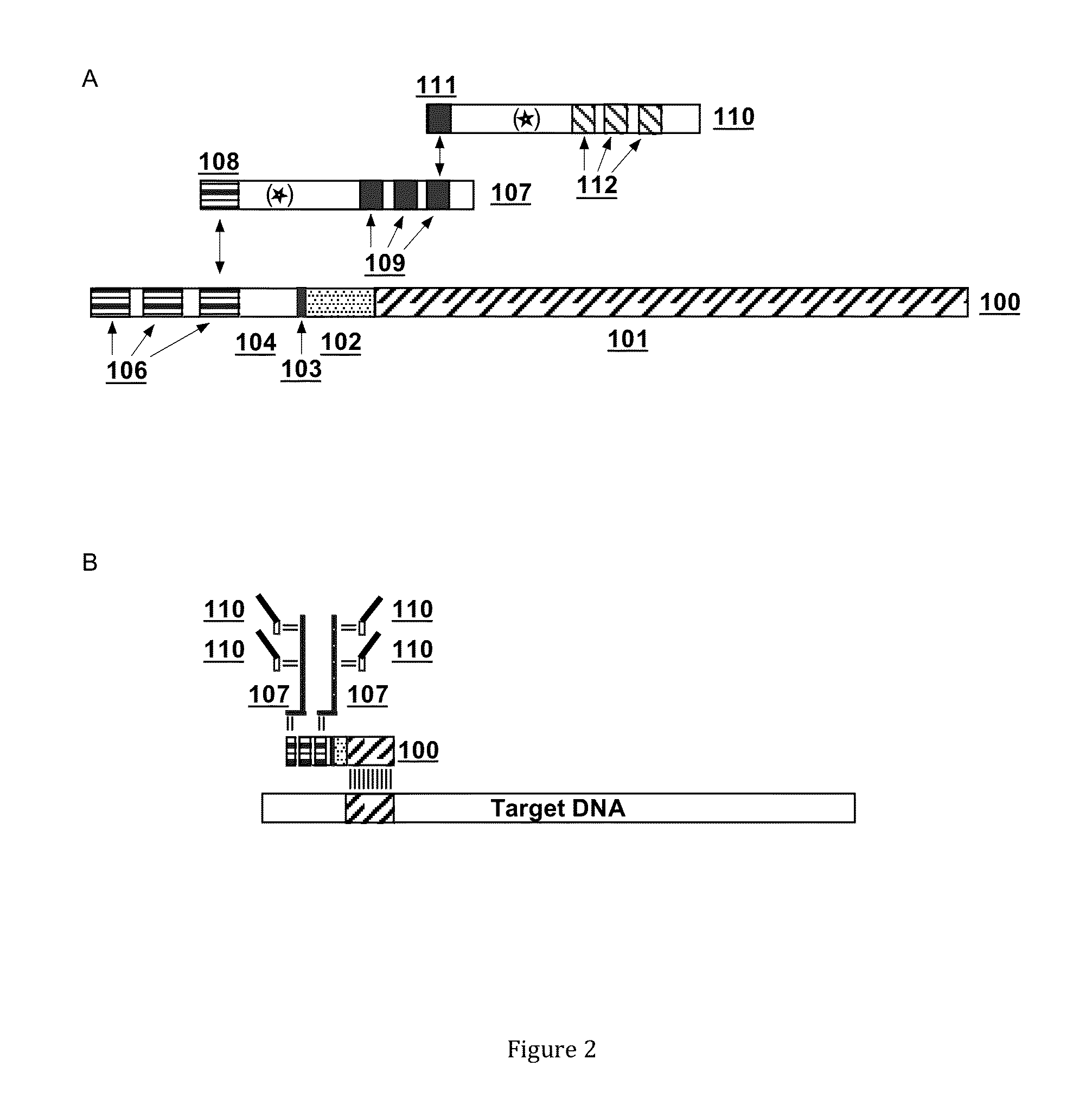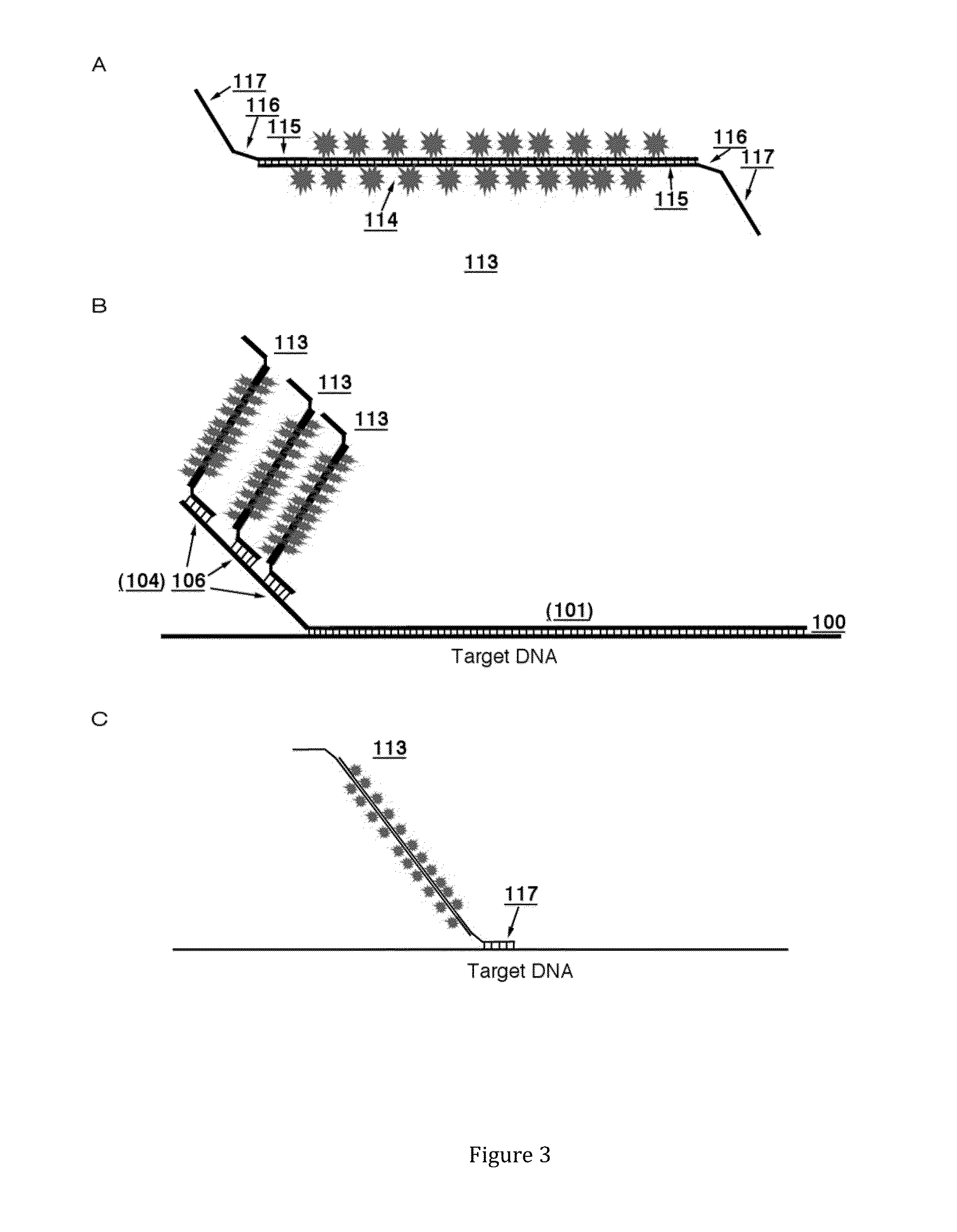Nucleic acid hybridization probes
a technology of nucleic acid and hybridization probes, applied in the field of nucleic acid detection systems, can solve the problems of rna-based probes often suffering in quality and reproducibility, and the typical harvest of such nucleic acids is relatively inefficient from such cultures
- Summary
- Abstract
- Description
- Claims
- Application Information
AI Technical Summary
Benefits of technology
Problems solved by technology
Method used
Image
Examples
example 1
Nucleic Acid Oligonucleotide Reagents
[0127]The oligonucleotides used for this example are presented in Table 1.
TABLE 1 SEQIDNO:Sequence (5′→3′)1CATGAACAATAACTAAGACAAGTTCTGTATCTATGTCTTATTCTAAAACTGATACTGAGACTTTGTCAGAATC / iSp9 / GGAGATGAGTGGATGGGAGAGAAGTG2CATGAACAATAACTAAGACAAGTTCTGTATCTATGTCTTATTCTAAAACTGATACTGAGACTTTGTCAGAATC / iSp9 / GTGGTAGGAGGGATGAATGTGAGTG3GCTCTGATTATGCCACCGTCCTTGATT.GCTCTGATTATGCCACCGTCCTTGATT.GCTCTGATTATGCCACCGTCCTTGATT / iSp9 / GCGATTCCGACACTCACC4GCCTCGCTCCAGACCTTGATACCGTTT.GCCTCGCTCCAGACCTTGATACCGTTT.GCCTCGCTCCAGACCTTGATACCGTTT / iSp9 / GCGATTCCGACACTCACC5AAGAGCTGAGACGGAGTCAGGAGC.AAGAGCTGAGACGGAGTCAGGAGC.AAGAGCTGAGACGGAGTCAGGAGC.AAGAGCTGAGACGGAGTCAGGAGC.AAGAGCTGAGACGGAGTCAGGAGC.AAGAGCTGAGACGGAGTCAGGAGC.AAGAGCTGAGACGGAGTCAGGAGC.AATCAAGGACGGTGGCATAATCAGAGC6TGGTGCTAGTTCTGGAGCTTGTGC.TGGTGCTAGTTCTGGAGCTTGTGC.TGGTGCTAGTTCTGGAGCTTGTGC.TGGTGCTAGTTCTGGAGCTTGTGC.TGGTGCTAGTTCTGGAGCTTGTGC.TGGTGCTAGTTCTGGAGCTTGTGC.TGGTGCTAGTTCTGGAGCTTGTGC.AAACGGTATCAAGGTCTGGAGCGAGGC7AATCAAGGACGGTGGCATAA...
example 2
Preparation of Labeled SEQ ID NOs:1 and 2
[0133]A. Amination of SEQ ID NOs:1 and 2:
[0134]To individual 40 μL aqueous solutions of SEQ ID NOs:1 and 2 (1000 μM), 160 μL of amination reagent (500 μL water, 300 μL TFA, 174 μL ethylenediamine and 95 mg Na2S2O3) was added. The resultant mixtures were vortexed and placed into an 80° C. water bath for 40 min, followed by desalting into water. The products were precipitated with isopropanol and sodium acetate and resuspended in 100 μL water to give SEQ ID NO:1-AM and SEQ ID NO:2-AM. The concentrations of SEQ ID NO:1-AM and SEQ ID NO:2-AM were determined spectrophotometrically at 260 nm to be 9818 μg / mL and 7409 μg / mL, respectively.
[0135]B. Conjugation of Fluorophore Labels to SEQ ID NO:1-AM and SEQ ID NO:2-AM:
[0136]A 2 μL volume of 1M NaOH was added to individual 50 μL aqueous samples containing SEQ ID NO:1-AM or SEQ ID NO:2-AM. After 1 min, a 50 μL of a mixture of DMSO / TMEDA / NaCl solution (50 μL DMSO, 50 μL of a mixture of 500 mM tetramethyl...
example 3
Preparation of Labeled SEQ ID NOs:5 and 6 (Signaling Agents):
[0137]A. Amination of SEQ ID NOs:5 and 6:
[0138]To a 20 μL volume of 10 mg / mL SEQ ID NOs:5 or 6 in water, a 180 μL volume of an amination reagent (1.0 mL water, 600 μL TFA, 348 μL ethylenediamine and 190 mg Na2S2O3) was added. Each solution was placed into a 65° C. water bath for 30 min, desalted into water and concentrated by ultrafiltration to a final volume of 120 μL. The concentrations of the SEQ ID NO:5-AM and SEQ ID NO:6-AM were determined spectrophotometrically. The concentrations of SEQ ID NO:5-AM and SEQ ID NO:6-AM were 840 μg / mL and 1329 μg / mL, respectively.
[0139]B. Conjugation of Fluorophore Labels to SEQ ID NO:5-AM and SEQ ID NO:6-AM:
[0140]SEQ ID NO:5-AM and SEQ ID NO:6-AM were conjugated to the activated labels 5(6)-SFX (6-(fluorescein-5-(and-6)-carboxamido) hexanoic acid, succinimidyl ester) (also known as Spectrum Green [SG]) and 5(6)-TAMRA, SE 5-(and-6)-carboxytetramethylrhodamine, succinimidyl ester (also k...
PUM
| Property | Measurement | Unit |
|---|---|---|
| Polarity | aaaaa | aaaaa |
| Spectroscopic properties | aaaaa | aaaaa |
| Nucleic acid sequence | aaaaa | aaaaa |
Abstract
Description
Claims
Application Information
 Login to View More
Login to View More - R&D
- Intellectual Property
- Life Sciences
- Materials
- Tech Scout
- Unparalleled Data Quality
- Higher Quality Content
- 60% Fewer Hallucinations
Browse by: Latest US Patents, China's latest patents, Technical Efficacy Thesaurus, Application Domain, Technology Topic, Popular Technical Reports.
© 2025 PatSnap. All rights reserved.Legal|Privacy policy|Modern Slavery Act Transparency Statement|Sitemap|About US| Contact US: help@patsnap.com



